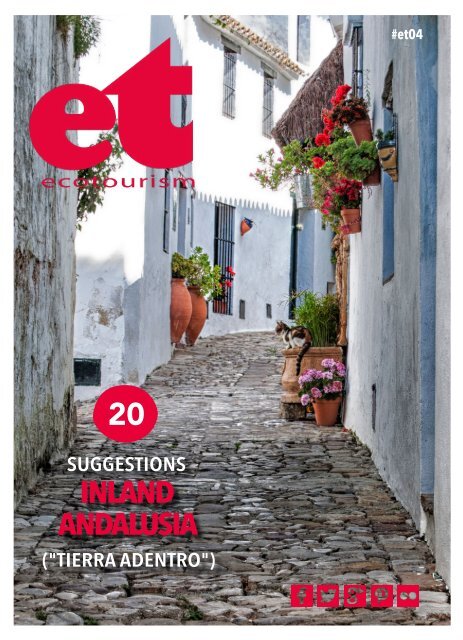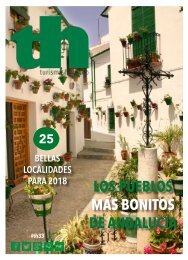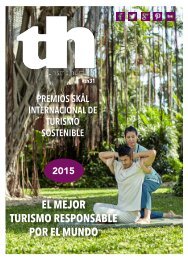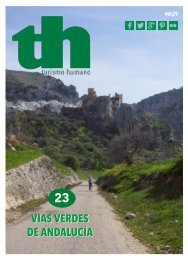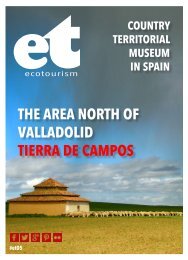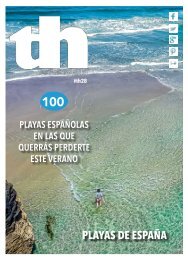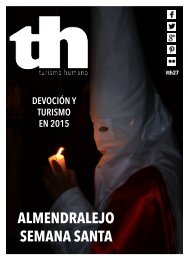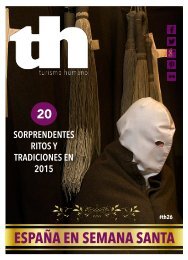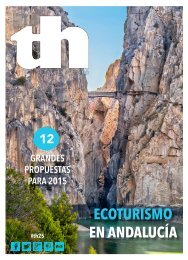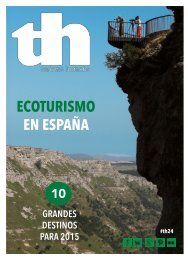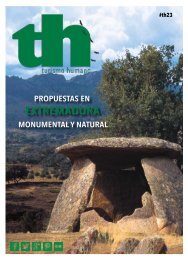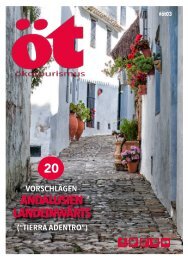Ecotourism 04. Inland Andalusia
During the last decade of last century, the segment of tourism to nature areas opened up in Andalusia, inland Andalusia is a unique offer within Spain and among the best in Europe.
During the last decade of last century, the segment of tourism to nature areas opened up in Andalusia, inland Andalusia is a unique offer within Spain and among the best in Europe.
You also want an ePaper? Increase the reach of your titles
YUMPU automatically turns print PDFs into web optimized ePapers that Google loves.
#et04<br />
20<br />
SUGGESTIONS<br />
INLAND<br />
ANDALUSIA<br />
("TIERRA ADENTRO")<br />
<strong>Ecotourism</strong> 1
Once you set foot in <strong>Andalusia</strong>,<br />
you are no longer just you. You become<br />
Your <strong>Andalusia</strong><br />
2 <strong>Ecotourism</strong><br />
andalucia.org
CONTENTS<br />
<strong>04.</strong> THE TRAIL OF THE WHITE-<br />
WASHED VILLAGES The Cádiz<br />
mountain range, with a rich architectural<br />
heritage.<br />
nº 04<br />
Suggestions <strong>Inland</strong> <strong>Andalusia</strong><br />
STAFF<br />
[Edited by] Concha Manjón/Entropía<br />
Ediciones<br />
[Published by] Salvador Hernáez<br />
[Textes] Comunicación y Turismo,<br />
S.L. / Handbook of tourism in<br />
Andalucía. Consejería de Turismo y<br />
Comercio de la Junta de Andalucía<br />
[Design] Alberto Álvarez de Perea<br />
[Community Manager] Alberto<br />
Álvarez de Perea<br />
[International] José Antonio Sierra<br />
[Commercial department]<br />
Concha Manjón / Estrella Torres<br />
[Webmaster] obolo.com<br />
[Translation] Isabelle Thévenet<br />
[Cover photo]<br />
Castellar de la Frontera (Cádiz)<br />
© Lorenzo Martín Iglesias<br />
08. CAZORLA This protection has<br />
made it a favourite destination for<br />
visitors in search of direct contact<br />
with nature.<br />
12. ALPUJARRA Its landscape is<br />
rugged as well is colourful, its orography<br />
is cut by ravines, gorges and<br />
valleys.<br />
16. SIERRA NEVADA It is the<br />
largest protected area in Spain and<br />
reserve of the Biosphere.<br />
24. CASTLES Andalucía is a land of<br />
contrasts, a passing point and coveted<br />
jewel since ancient times with<br />
numerous fortified towns.<br />
32. WALKING Walking is an ideal<br />
way of coming in contact with nature.<br />
There are routes for all ages<br />
and different degrees of difficulty.<br />
36. INTERMEDIATE CITIES The<br />
Medium-Sized Cities in the Centre of<br />
<strong>Andalusia</strong> have played an important<br />
role in the history of this region.<br />
42. THE IBERIAN HAM The Iberian<br />
ham is the ambassador of andalusien<br />
gastronomy dans le monde.<br />
<strong>Ecotourism</strong> 3
White Villages<br />
Cádiz<br />
Zahara de la Sierra (Cádiz)<br />
4 <strong>Ecotourism</strong>
The Trail of the<br />
Whitewashed Villages<br />
SHEMSU.HOR<br />
This is one of the most<br />
spectacular routes in<br />
Andalucía where the<br />
history and cultures of the<br />
civilisations that settled here<br />
left deep marks. The white<br />
villages get their name from<br />
the tradition of frequently<br />
whitewashing the outside of<br />
their houses and they have<br />
typical narrow streets and<br />
red roofs.<br />
Many of these villages still<br />
have a castle or the ruins of<br />
one. This traditional route<br />
starts at Arcos de la Frontera<br />
(Cádiz); it goes through Ronda<br />
(Málaga) and descends to<br />
Castellar de la Frontera.<br />
A total of 250 kilometres<br />
through pure nature. There<br />
are species on route like the<br />
Spanish fir (abies pinsapo)<br />
in the Nature Park of los<br />
Alcornocales and also in the<br />
Sierra de Grazalema.<br />
There are numerous rural<br />
hotels, farms and ancient<br />
mansions adapted to provide<br />
accommodation, campsites<br />
and recreation areas.<br />
The Cádiz mountain range,<br />
with a rich architectural<br />
heritage, stretches to the<br />
north of the province along<br />
a steep, beautiful, green and<br />
thrilling route: the Trail of<br />
<strong>Ecotourism</strong> 5
White Villages<br />
Cádiz<br />
the Whitewashed Villages.<br />
Arcos de la Frontera, granted the historic-artistic<br />
designation, is one of the most<br />
famous whitewashed villages. It is followed<br />
by Ubrique, El Bosque and Prado del Rey,<br />
not only famous for their stunning scenery,<br />
but also for their arts and crafts.<br />
Casares, El Gastor, Espera, Gaucín, Genalguacil,<br />
Grazalema, Montejaque, Olvera,<br />
Prado del Rey, Ronda, Setenil de las Bodegas,<br />
Ubrique, Vejer de la Frontera, Villaluenga<br />
del Rosario, Villamartín and Zahara de la<br />
Sierra.<br />
Olvera (Cádiz)<br />
The village of El Gastor is called the “Balcony<br />
of the white villages” because of its<br />
whiteness and from its highest point (1.060<br />
metres) you can look down on the marvellous<br />
view over the neighbouring<br />
villages.<br />
Algar, Algodonales, Puerto<br />
Serrano, Benaocaz, Bornos,<br />
Espera, Villamartín, Olvera<br />
and Villaluenga del Rosario<br />
are also part of the trail.<br />
The trail goes deep into<br />
the Grazalema Nature<br />
Reserve, declared a Biosphere<br />
Reserve. Here you<br />
must visit the town of the<br />
same name, and Zahara<br />
de la Sierra, which has one<br />
of the most dramatic landscapes<br />
in the area. Finally, you<br />
will find Alcalá del Valle and<br />
Setenil de las Bodegas, with<br />
their unusual layout of houses<br />
built into the mountain, following<br />
the river's course.<br />
The villages on this route are Alcalá de los<br />
Gazules, Algodonales, Algatocín, Arcos de<br />
la Frontera, Benaocaz, El Bosque, Bornos,<br />
JAMES GORDON<br />
6 <strong>Ecotourism</strong>
Setenil de las Bodegas (Cádiz)<br />
JMANTEAU<br />
<strong>Ecotourism</strong> 7
Cazorla (Jaén)<br />
Cazorla<br />
Jaén<br />
The Nature Park of Cazorla,<br />
Segura y Las Villas<br />
This nature park, one of the<br />
largest in Spain with an area<br />
of 214.300 hectares, has been<br />
declared to be a reserve of the Biosphere<br />
by the UNESCO as well as a<br />
Special protection Zone for Birds by<br />
the European Union. It has a wealth<br />
of synergetic species that has favoured<br />
its declaration as a National<br />
Hunting Reserve of Cazorla and<br />
Segura. This protection has made it<br />
a favourite destination for visitors in<br />
search of direct contact with nature.<br />
It has an excellent offer for hotels<br />
and holiday cottages as well as<br />
numerous sports offers in the heart<br />
of nature.<br />
The rivers Guadalquivir and Segura<br />
have their source in this nature<br />
park, two rivers that flow through<br />
incomparable landscapes and the<br />
possibility to get to know over a<br />
hundred endemic species, notably<br />
the “Cazorla violet” and you can<br />
also see 36 different types of mammals<br />
in their natural environment,<br />
including the mountain goat, deer,<br />
fallow deer, moufflon, otter; mongoose,<br />
fox and birds of prey like<br />
the golden eagle; griffon vultures<br />
fly overhead, while back on land<br />
you can see the Valverde lizard, an<br />
endemic species.<br />
Places of interest in the Park’s area<br />
of interest:<br />
• The Tranco de Beas reservoir,<br />
remains of the San Miguel castle,<br />
Bujaraiza, de la Bolera and<br />
Aguas Negras<br />
• The Anchuricas and Valdeazores<br />
lagoons<br />
• The Negra, Cañada Catena,<br />
Montiñana, Los Parrales and<br />
Higuera fountains<br />
• The Bayona, Fresnedilla and El<br />
Robledo fountains<br />
• The Coto Ríos, Llanos de Arance,<br />
la Pascuala fountain<br />
• El Yelmo<br />
• The Saucejo and Cueva del Peinero<br />
refuges<br />
• The source of the river Guadalquivir<br />
• Las Buitreras<br />
• “Salto de los Órganos”<br />
waterfall on the river<br />
Borosa<br />
• Collado del Almendral<br />
synergetic<br />
park<br />
• The templar castle<br />
and the Tíscar<br />
watchtower.<br />
• The Moorish and<br />
Christina castles of<br />
Cazorla<br />
• The historic part of<br />
Segura de la Sierra<br />
TREVOR HUXHAM<br />
8 <strong>Ecotourism</strong>
RANDI HAUSKEN<br />
<strong>Ecotourism</strong> 9
Úbeda / Baeza<br />
Jaén<br />
Úbeda and Baeza<br />
World Heritage Sites<br />
Beautiful churches, impressive palaces,<br />
manor houses or surprising<br />
streets make up a monumental<br />
heritage impregnated with aesthetic and<br />
renovating feeling of the Renaissance style.<br />
Time has stood still in Úbeda and Baeza,<br />
declared to be a World Heritage Site.<br />
In Úbeda, you can see some of<br />
the main works of Andrés<br />
de Vandelvira around<br />
the plaza del Salvador<br />
like the Palace<br />
of the Vázquez,<br />
the palace of<br />
the Marqués<br />
de Mancera,<br />
the Granary,<br />
the building<br />
that houses<br />
the Parador de<br />
Turismo hotel<br />
and the church<br />
of the Salvador,<br />
the project of Diego<br />
de Siloé.<br />
The route passes the palace<br />
of the Conde de Guadiana, the<br />
House of the Towers, with a beautiful<br />
Renaissance style patio and the Hospital<br />
de Santiago.<br />
In Baeza the following are outstanding<br />
examples, the Town Hall, the complex of<br />
the Palace of Jabalquinto, the seminary of<br />
San Felipe de Neri, the Cathedral and the<br />
Baeza (Jaén)<br />
buildings around the plaza del Pópulo and<br />
the church of San Francisco<br />
In Jaén visitors can appreciate the Cathedral,<br />
Vandelvira intervened in the project<br />
and he is responsible for the Capitular<br />
Hall and the Vestry, a masterpiece<br />
in Spanish architecture.<br />
ANNA & MICHAL<br />
Continuing the route in<br />
the province of Jaén in<br />
Martos we have the<br />
Town Hall; in Huelma<br />
the parish<br />
church.<br />
Canena and<br />
Sabiote can<br />
boost of their<br />
magnificent Renaissance<br />
castles;<br />
in Villacarrillo<br />
there is the church<br />
of la Asunción and<br />
in Cazorla, besides the<br />
ruins of its parish church<br />
there is the Cadenas fountains.<br />
The route of Vandelvira and Renaissance<br />
aims at recovering civil, religious and military<br />
buildings from the sixteenth century<br />
for tourist use and in this way combining a<br />
territorial area rich in its monumental and<br />
historic heritage.<br />
10 <strong>Ecotourism</strong>
Sacra Capilla del Salvador. Úbeda (Jaén)<br />
RANDI HAUSKEN<br />
<strong>Ecotourism</strong> 11
Bubión (Granada)<br />
La Alpujarra<br />
Granada<br />
The Route of<br />
the Alpujarra<br />
La Alpujarra is situated<br />
between the Sierra<br />
Nevada, in Granada,<br />
and the sierra de Lújar and<br />
the sierra de Gádor in Almería.<br />
This area opens onto<br />
the Mediterranean from the<br />
heights of Mulhacén, the<br />
highest peak on mainland<br />
Spain. Its landscape is rugged<br />
as well is colourful, its orography<br />
is cut by ravines, gorges<br />
and valleys. The villages of<br />
this district repose and some<br />
times climb the slopes here,<br />
discovered by travellers in<br />
search of peace and quiet,<br />
good food and an excellent<br />
offer of action holidays:<br />
hiking routes, mountain treks<br />
on horseback, forests where<br />
stressed executives can get<br />
rid of their accumulated<br />
adrenaline by taking part in<br />
in “war games”.<br />
This area was inhabited by<br />
Phoenicians and Romans,<br />
however it was the eight centuries<br />
of Moorish presence<br />
that gave it its actual appearance,<br />
with architecture in<br />
the form of steps, irrigation<br />
by means of channels and<br />
ditches, the gastronomy and<br />
traditions and even the way<br />
of life where time is relative.<br />
Isolated and with difficult<br />
access for centuries, this land<br />
stayed virgin until recently.<br />
The village of the Alpujarra,<br />
with their white houses, the<br />
typical chimney pots and<br />
their terraces or “terraos”<br />
planted with geraniums and<br />
carnations, they tumble<br />
down the slopes between<br />
green forests with chestnut<br />
and walnut trees and the<br />
murmur of the water from<br />
the melting snow running<br />
down from the heights of<br />
Sierra Nevada.<br />
The beauty of these villages<br />
is only one<br />
of their many<br />
attractions.<br />
Lanjarón,<br />
spa town,<br />
famous<br />
for the<br />
longevity<br />
and<br />
good<br />
health<br />
of its<br />
in-<br />
habi-<br />
12 <strong>Ecotourism</strong><br />
Capilerilla (Granada)<br />
ARCHIVE
JEANNE MENJ<br />
<strong>Ecotourism</strong> 13
La Alpujarra<br />
Granada<br />
Trevélez (Granada)<br />
This area was inhabited<br />
the eight<br />
14 <strong>Ecotourism</strong><br />
RANDI HAUSKEN
y Phoenicians and Romans, however it was<br />
centuries of Moorish presence<br />
ARCHIVE<br />
tants, is the gateway to this<br />
surprising Alpujarra district.<br />
Along the Poqueira valley,<br />
from Órgiva you ascend to<br />
the highest village in Spain,<br />
Trévelez, famous for its delicious<br />
ham.<br />
Other villages perched on<br />
the way up to the Veleta and<br />
Mulhacén are Pampaneira,<br />
Bubión and Capileira. They<br />
say this is an area of spirits<br />
and witchcraft, besides having<br />
a cuisine with a strong<br />
personality, based on pork<br />
products.<br />
The river Guadalfeo cuts this<br />
district across in two, forming<br />
the High Alpujarra and<br />
the low Alpujarra. The high<br />
part is south of Sierra Nevada<br />
with beautiful villages<br />
like Bérchules, Busquístar,<br />
Mecina<br />
Fondales,<br />
Jubiles or<br />
Yegen.<br />
The Low<br />
Alpujarra<br />
is the<br />
part<br />
of the<br />
Contraviesa<br />
mountain<br />
chain, with<br />
villages with<br />
a marked personality<br />
like Lújar,<br />
Sorvilán and Albondón, to<br />
mention a few.<br />
Villages that have marvelled<br />
local people and<br />
visitors alike. Pedro Antonio<br />
de Alarcón dedicated his<br />
first book of travels to the<br />
Alpujarra and the hispanist<br />
Gerald Brenan, who lived in<br />
Yegen, wrote “South from<br />
Granada” about the Alpujarra.<br />
For Federico García Lorca,<br />
the Alpujarra was the<br />
“country of nowhere”.<br />
Songs and dance make up<br />
an important part of a rich<br />
folklore and an ancestral<br />
tradition.<br />
The Moors and Christians<br />
festivals are celebrated in<br />
many of the villages, with<br />
the trovero verses from the<br />
Alpujarra being some of the<br />
most original. Two troveros<br />
take turns to sing, improvising<br />
the words as they go<br />
on.<br />
The fertile Lecrín valley is<br />
next to the Alpujarra, with<br />
plantations of oranges and<br />
lemons perfuming the air<br />
with their sweet blossom in<br />
springtime. Ancient flourmills,<br />
Moorish castles and<br />
farmsteads dot this quiet<br />
and luminous district.<br />
<strong>Ecotourism</strong> 15
Sierra Nevada<br />
Granada<br />
Lagunas de Yeguas en Sierra Nevada (Granada)<br />
16 <strong>Ecotourism</strong>
The Sierra Nevada<br />
National Park<br />
Right in the heart of<br />
the Penibética mountain<br />
chain, the National<br />
Park of Sierra Nevada is<br />
in the provinces of Granada<br />
and Almería, with an area of<br />
169.239 hectares and no less<br />
than 67 municipalities, 44 in<br />
the province of Granada and<br />
23 in the province of Almería.<br />
It is the largest protected<br />
area in Spain and the two<br />
highest peaks on mainland<br />
Spain are here, the Veleta<br />
and Mulhacén, with their<br />
perpetual snow on the north<br />
face of Sierra Nevada. In the<br />
east towards the province<br />
of Almería, it touches the<br />
foothills of the only desert in<br />
Europe in Tabernas.<br />
It has been declared to be<br />
a reserve of the Biosphere<br />
by the UNESCO and it has a<br />
high ecological and cultural<br />
worth with villages, especially<br />
in the Alpujarra in both<br />
the province of Granada as<br />
well as in Almería, that have<br />
kept their Moorish past and<br />
many of the agricultural<br />
techniques from the Middle<br />
Ages.<br />
This is the case of the irrigation<br />
system along channels<br />
and ditches that cut across<br />
JOSÉ Mª LUQUE<br />
<strong>Ecotourism</strong> 17
Sierra Nevada<br />
Granada<br />
Sierra Nevada is an exc<br />
becaus<br />
18 <strong>Ecotourism</strong><br />
Sierra Nevada (Granada)
eptional refuge for flora and its bio-diversity<br />
e of its geographic isolation<br />
the mountain sides collecting<br />
water from the thawing<br />
snow to water small market<br />
gardens.<br />
Sierra Nevada is an exceptional<br />
refuge for flora and<br />
its bio-diversity because of<br />
its geographic isolation, the<br />
steep sides of the ecological<br />
slopes and the diversity of<br />
its ecological nooks. It has<br />
2.100 catalogued vegetal<br />
species, 116 of them are<br />
endangered.<br />
Places of special interest<br />
close to Sierra Nevada:<br />
• Mulhacén (3.481 m),<br />
Veleta, el Alcazaba and<br />
el Cartujo Peaks<br />
• Trevenque Needle<br />
• Altera glacial lagoons (at<br />
3.146 m.)<br />
• The Mulhacén hollow, la<br />
Caldera, Corral del Veleta<br />
or de Valdeinfierno.<br />
• Aguas Verdes and Guarnón<br />
and the area of the<br />
lagoons (Larga, Caldera,<br />
Mosca, Aguas Verdes,<br />
Sietre Lagunas and<br />
others)<br />
• Ski resort of Borreguiles<br />
and Pradollano<br />
• And of course, all the villages<br />
in the Alpujarras in<br />
the provinces of Granada<br />
and Almería.<br />
DOCTOR CANON<br />
<strong>Ecotourism</strong> 19
Doñana<br />
Huelva<br />
Doñana<br />
World Heritage<br />
Site<br />
The National park of Doñana was declared<br />
by the UNESCO to be a reserve of the Biosphere<br />
and a World Heritage Site in recognition<br />
of its merits that possibly make it the<br />
most significant protected area in Spain.<br />
A National Park since 1969 and an area of<br />
50.720 hectares, it is situated in the provinces<br />
of Huelva and Seville.<br />
Doñana and its district are made up of flat<br />
lands with marshes and sand dunes, situated<br />
between the ancient terraces of the<br />
river Guadalquivir, in the provinces of Huelva<br />
and Seville.<br />
The absence of relief is one of its characteristics<br />
and this orography made it<br />
accessible for different civilisations<br />
to settle here with<br />
their economy based on<br />
the wealth of the land,<br />
the streams, rivers and<br />
the sea; that provided<br />
grazing for the cattle,<br />
abundant and varied<br />
game, as well as<br />
good fishing along the<br />
extensive coast; there<br />
was also honey, salt and<br />
other produce from the<br />
marshes.<br />
ARCHIVE<br />
Mazagón (Huelva)<br />
20 <strong>Ecotourism</strong>
Parc National de Doñana en Almonte (Huelva)<br />
<strong>Ecotourism</strong> 21
Doñana<br />
Huelva<br />
At present, the National<br />
Park of Doñana keeps its<br />
traditions alive, at the same<br />
time it is open to new times<br />
with the main objective of<br />
continuing to be the most<br />
important wetlands in Europe.<br />
Each year flocks of geese<br />
arrive in tens of thousands,<br />
establishing their winter<br />
home here in the marshes.<br />
Large colonies of spoonbills,<br />
purple herons, night<br />
herons, squacco herons,<br />
storks make the tree tops of<br />
the old cork oaks into giant<br />
birdcages, a unique sight,<br />
especially at sunset.<br />
The Iberian lynx and the imperial<br />
eagle are emblematic<br />
species in the National<br />
Park of Doñana. For nature<br />
lovers, there are companies<br />
dedicated to action<br />
holidays that organise<br />
excursions.<br />
• The most extensive<br />
beach of all<br />
the mainland coasts,<br />
from Sanlúcar de Barrameda<br />
(Cádiz) to Mazagón<br />
(Huelva)<br />
• The Caveros well of Roman<br />
origins.<br />
• Nature Interpretation<br />
and Reception Centres<br />
• Acebuche Lagoon<br />
• Rocina Stream<br />
• The Coto del Rey y del<br />
Faro pine grove<br />
• The Hinojos marshes<br />
• The Asperillo cliffs on the<br />
coast of Almonte<br />
• Romería type pilgrimage<br />
to Rocío<br />
• The Marismillas and Matasgordas<br />
forests<br />
• The Towers of el Loro,<br />
la Higuera, Carbo-nero<br />
Zalabar and San Jacinto<br />
• The Aviario lagoon<br />
• The Acebrón palace and<br />
pond<br />
Places of special<br />
interest close to the<br />
Doñana National<br />
Park:<br />
22 <strong>Ecotourism</strong><br />
ARCHIVE<br />
PEDRO CARRILLO
Matalascañas (Huelva)<br />
<strong>Ecotourism</strong> 23
Castles<br />
<strong>Andalusia</strong><br />
Château de La Mota en Alcalá la Real (Jaén)<br />
24 <strong>Ecotourism</strong>
The route of the Castles<br />
AYTO. ALCALÁ LA REAL<br />
<strong>Andalusia</strong> is a land of<br />
contrasts, a passing<br />
point and coveted<br />
jewel since ancient times<br />
with numerous fortified<br />
towns as well as castles,<br />
alcazabas, alcázares and<br />
watchtowers dotting its<br />
geography. As well as the armies<br />
that marched through<br />
the lands of Andalucía, the<br />
soldiers were followed by<br />
monks who also built monasteries<br />
and part of the<br />
nobility converted the castles<br />
into palaces, especially<br />
during the Renaissance<br />
period.<br />
With the arrival of<br />
Napoleon’s troops, the abolition<br />
of mortmain and with<br />
the nobility abandoning<br />
castles and palaces, a period<br />
of abandon started and the<br />
patio of the Vélez Blanco<br />
castle was even sold to the<br />
Museum of New York.<br />
Historically Jaén is the key<br />
to Andalucía because of its<br />
strategic situation and the<br />
number of fortifications<br />
were built here especially<br />
during the kingdoms of Taifas.<br />
These important forts<br />
were designed by the Moors<br />
and rebuilt by the Christians.<br />
This route takes us through<br />
Baños de la Encina with its<br />
<strong>Ecotourism</strong> 25
Castles<br />
<strong>Andalusia</strong><br />
Historically Jaén i<br />
situati<br />
26 <strong>Ecotourism</strong><br />
Chateâu de Baños de la Encina (Jaén)
s the key to <strong>Andalusia</strong> because of its strategic<br />
on and the number of fortifications<br />
castle that controlled the<br />
entrance into <strong>Andalusia</strong><br />
from Castile through the<br />
Despeñaperros pass and to<br />
the Santa Catalina castle in<br />
the city of Jaén that was the<br />
residence of the king San<br />
Fernando. In Segura de la<br />
Sierra, Cazorla, Sabiote and<br />
la Iruela there are impressive<br />
military forts.<br />
Seville has conserved its<br />
Alcázar, where Moorish and<br />
Christian art blend and there<br />
are other examples like the<br />
Silver and Gold towers as<br />
well as the Cartuja de las<br />
Cuevas, it was a residency<br />
for a time and Christopher<br />
Columbus’ tomb is here.<br />
King Fernando the Christian<br />
king, was the main impelling<br />
force behind the construction<br />
of castles and monasteries<br />
in this province. Leaving<br />
the city of Seville you head<br />
for Espartinas, Santiponce<br />
(monastery of San Isidoro<br />
del Campo), La Algaba with<br />
the Torre de los Guzmanes<br />
tower and continuing until<br />
you reach Cazalla de la<br />
Sierra.<br />
There is a second itinerary<br />
that leaves Carmona with<br />
the remains of the Roman<br />
and Moorish defensives,<br />
DIPUTACIÓN DE JAÉN<br />
<strong>Ecotourism</strong> 27
Castles<br />
<strong>Andalusia</strong><br />
Cádiz and Málaga we<br />
28 <strong>Ecotourism</strong><br />
Chateâu de Otíñar (Jaén)
e lands on the frontier and consequently heavily<br />
fortified<br />
JOSÉ JIMÉNEZ GARRIDO<br />
and goes to Alcalá de Guadaíra<br />
and Utrera, with three<br />
splendid castles in the countryside<br />
Los Molares, Las<br />
Aguzaderas and the Cote<br />
castles, passing through<br />
Montellano.<br />
The marks on the places<br />
related to Christopher Columbus<br />
are unmistakable,<br />
especially in La Rábida with<br />
its small Franciscan convent:<br />
Moguer and its Santa Clara<br />
monastery which has been<br />
recently restored, is on the<br />
same route. You also have<br />
to visit Niebla and go into<br />
rapture before the personality<br />
of the Guzmanes castle<br />
as well as Lucena del Puerto,<br />
the Hacienda de la Luz.<br />
There is another route that<br />
leaves Aroche and Cortegana<br />
through the mountains<br />
of Aracena, where there are<br />
fortifications that were built<br />
to deter any possible attack<br />
by Portuguese invaders. You<br />
complete this route by visiting<br />
Almonáster, Cumbres<br />
Mayores and Santa Olalla<br />
with its castle.<br />
Cádiz and Málaga were<br />
lands on the frontier and<br />
consequently heavily fortified.<br />
There is a route that<br />
sets off from the Medieval<br />
image of the village of Olvera<br />
with the ruins of its castle,<br />
<strong>Ecotourism</strong> 29
Castles<br />
<strong>Andalusia</strong><br />
In Córdoba you ca<br />
Some of the castle<br />
30 <strong>Ecotourism</strong><br />
Chateâu de Luque (Córdoba)
n see the intense power of the noble estates.<br />
s and palaces are in the hands of the nobility<br />
ARCHIVE<br />
you continue on to Ronda<br />
that has conserved some<br />
parts of its walls. The castles<br />
of Atajate and Benaladid are<br />
cemeteries today, the bastions<br />
of Jimena and Castellar<br />
de la Frontera have been<br />
conserved, the Almoraima<br />
convent is in this municipality,<br />
built in the sixteenth<br />
century and occupied by the<br />
Mercedarians. And in Tarifa,<br />
at the end of this route, the<br />
impressive castle of Guzmán<br />
el Bueno (eleventh century)<br />
that recalls the legendary<br />
heroic deed of the knight<br />
who preferred to lose his<br />
son rather than surrender to<br />
the Moors.<br />
In Córdoba you can see the<br />
intense power and impetus<br />
of the noble estates, this is<br />
such that some of the castles<br />
and palaces are in the<br />
hands of the nobility, like<br />
the Almodóvar castle situated<br />
on the banks of the river<br />
Guadalquivir, with its eight<br />
defiant towers.<br />
Continue on to the city of<br />
Córdoba (monastery of San<br />
Jerónimo, Alcázar de los<br />
Reyes Católicos, Torre de<br />
la Calahorra) and then to<br />
Espiel and Bélmez with the<br />
rocky castle and then on<br />
to the magnificent forts at<br />
Belalcázar.<br />
<strong>Ecotourism</strong> 31
Action Tourism<br />
<strong>Andalusia</strong><br />
Rivera de Huesna. Vía Verde Sierra Norte de Sevilla<br />
32 <strong>Ecotourism</strong>
Walking<br />
Walking is an ideal way of<br />
coming in contact with<br />
nature. There are routes<br />
for all ages and different degrees of<br />
difficulty. The inland nature parks<br />
and the nature reserves have very<br />
attractive itineraries. Walking as<br />
well as cycling is more and more<br />
popular along some of the ancient<br />
train lines no longer in use.<br />
Rights of way have been recovered,<br />
there are riverbeds and extensive<br />
sand dunes near the beaches, all<br />
excellent walking, like the area<br />
surrounding the Doñana<br />
National Park,<br />
or through the<br />
marshes at the<br />
estuary of the<br />
Guadalquivir<br />
river. In Málaga<br />
there are<br />
marked walks<br />
through the<br />
Torcal in Antequera<br />
and the<br />
ancient routes<br />
through villages in<br />
the Axarquía in the province<br />
of Málaga, like the<br />
ones that leaves Torrox,<br />
down to Frigiliana and on<br />
to Nerja and then ascends up the<br />
river Chillar.<br />
Sierra Nevada (Granada)<br />
In Cazorla there is the famous track<br />
named after Félix Rodríguez de la<br />
Fuente, in honour of this eminent<br />
naturalist, along 16 kilometres<br />
through beautiful countryside. There<br />
are also routes in the Alpujarra<br />
in Granada, “white trekking” with<br />
snow shoes.<br />
In fact, Andalucía offers a wide<br />
network of routes in its promotions<br />
of inland areas through exuberant<br />
and attractive landscapes that put<br />
you in contact with the flora in the<br />
mountain villages or the varied fauna<br />
that lives in the mountains and<br />
nature parks.<br />
Mountaineering<br />
<strong>Andalusia</strong> is very mountainous and<br />
home to the highest peaks<br />
on mainland Spain, Mulhacén<br />
and el Veleta<br />
in Sierra Nevada in<br />
Granada. There is<br />
an excellent network<br />
of parador<br />
hotels, youth<br />
hostels, mountain<br />
shelters<br />
and places where<br />
you can camp wild<br />
in the mountains,<br />
mythical places like<br />
the Sierra Morena, the<br />
Bética mountain chain,<br />
Cazorla, Segura y Las<br />
Villas, the mountains of<br />
Grazalema in Cádiz and Los Alcornocales,<br />
not forgetting the Picos<br />
de Aroche and Sierra de Aracena<br />
in Huelva. As well as the Sierra de<br />
Filabres in Tabernas (Almería) or the<br />
Gaitanes Gorge (Málaga) where as<br />
well as mountaineering there are<br />
ideal crags for rock climbing.<br />
JUANPOL.COM<br />
ARCHIVE<br />
<strong>Ecotourism</strong> 33
Action Tourism<br />
<strong>Andalusia</strong><br />
Río Borosa. Cazorla (Jaén)<br />
34 <strong>Ecotourism</strong>
Horse trekking<br />
The horse is always<br />
present in the history<br />
and culture of Andalucía<br />
and it is a symbol that<br />
identifies <strong>Andalusia</strong>. The<br />
horse has played a main role<br />
in historic feats and it is an<br />
important sports and leisure<br />
complement today. The<br />
horse offers several holiday<br />
options and discovering<br />
them in the heart of nature<br />
is one of the passionate<br />
tourist offers in Andalucía.<br />
Many of the fairs and romería<br />
type pilgrimages that<br />
are celebrated in Andalucía<br />
include the horse as one of<br />
the primordial elements.<br />
There is a simple option and<br />
perhaps one of the most<br />
gratifying: to go on a horse<br />
trek; that is ride through<br />
nature areas on a few days’<br />
trek to discover the provocative<br />
beauty, visit villages<br />
where the pace of life is<br />
slow like in times gone by<br />
and experience traditions<br />
that help you to get to know<br />
<strong>Andalusia</strong>. You can also take<br />
riding lessons. There are<br />
many <strong>Andalusia</strong>n cortijos<br />
type farms converted into<br />
rural accommodation the<br />
offer the chance of spending<br />
a few days with monitors<br />
showing you how to ride, it<br />
is a sport but also an art.<br />
ARCHIVE<br />
<strong>Ecotourism</strong> 35
Intermediate Cities<br />
<strong>Andalusia</strong><br />
Medium-Sized<br />
Cities in the Centre<br />
of <strong>Andalusia</strong><br />
Antequera, right in the heart of Andalucía,<br />
is known as the city of white Gongorine<br />
churches to use the words of Gerardo<br />
Diego, a monumental town with outstanding<br />
monuments like the Alcazaba, the Coll-egiate<br />
church of Santa María la Mayor, the convent of<br />
Nuestra Señora de los Remedios and the Giants’<br />
Arch. From the Collegiate you can look down on<br />
the town with its many bell-gable church towers<br />
cutting the skyline.<br />
Archidona is not only famous for its plaza<br />
Ochavada (eighteenth century) but also for its<br />
rich past when different civilisations and cultures<br />
settled in the town, thanks to its privileged<br />
geographic position. Declared a Artistic Historic<br />
Complez, its Punic-Roman castle stands out<br />
among its monuments, converted<br />
into the Sanctuary of Our<br />
Lady of Grace, together<br />
with the Santo Domingo<br />
convent from the<br />
sixteenth century and<br />
the convent of Jesús<br />
and Mary from the<br />
same date.<br />
Osuna is an artistic,<br />
historic and monumental<br />
jewel. Part of<br />
the Route of Washington<br />
Irving from the Andalusí Legacy,<br />
it is a reference point for<br />
36 <strong>Ecotourism</strong><br />
Torcal de Antequera (Málaga)<br />
ARCHIVE
Alcazaba. Antequera (Málaga)<br />
TREVORD HUXHAM<br />
<strong>Ecotourism</strong> 37
Intermediate Cities<br />
<strong>Andalusia</strong><br />
The Medium-Sized C<br />
importa<br />
<strong>Andalusia</strong>n baroque with its civil buildings<br />
in the San Pedro street and dominated the<br />
town, the Collegiate and the University.<br />
There are important churches and convents<br />
on the route through the town, like the palace<br />
of the Dukes of Osuna.<br />
Écija, known as the city of the sun and the<br />
City of Towers. Its greatest splendour dates<br />
from Roman times. There are two routes<br />
through this town for you to discover its<br />
personality. One is the route of the Towers<br />
and the Palaces and the other is the route<br />
of the Bell-gable Towers with the eleven<br />
towers that crown the roofs of Écija. A visit<br />
to the museum is well worth while because<br />
of the valuable Roman exhibits.<br />
The origins of Carmona is Carthaginian and<br />
in Roman times it was one of the main places<br />
in the countryside of Seville; in times of<br />
al-Ándalus it was the capital of the principality,<br />
it is logical consequently that its monumental<br />
and cultural offer is linked to this<br />
rich past. We have Roman Carmona with its<br />
necropolis; the medieval town in<br />
andalusí style that mixed with<br />
Christian elements and the<br />
strong presence of the<br />
baroque touches in its<br />
churches and palaces.<br />
Loja in the province of<br />
Granada with the river<br />
Genil as the inseparable<br />
companion of its<br />
history, the water that<br />
flows from the springs<br />
here is one of its marks of<br />
identification, together with<br />
38 <strong>Ecotourism</strong><br />
Carmona (Sevilla)<br />
ARCHIVO
ities in the Centre of <strong>Andalusia</strong> have played an<br />
nt role in the history of this region<br />
Osuna (Sevilla).<br />
ARTEALIA<br />
<strong>Ecotourism</strong> 39
Intermediate Cities<br />
<strong>Andalusia</strong><br />
This part of inland A<br />
great artisti<br />
40 <strong>Ecotourism</strong><br />
Loja (Granada)
ndalusia is home to numerous monuments of<br />
c value in the six medium-sized cities<br />
monuments like La Alcazaba,<br />
the church of the Encarnación<br />
with its octagonal<br />
tower or the church of San<br />
Gabriel, one of the most interesting<br />
works from <strong>Andalusia</strong>n<br />
Renaissance.<br />
Alcalá la Real is situated<br />
in the Sierra Sur in Jaén, its<br />
strategic value was the key<br />
for different civilis-ations<br />
that settled here. Its La<br />
Mota fort, dating back to<br />
Moorish times, is its main<br />
monument; it is being restored<br />
at present.<br />
Baeza is a World Heritage<br />
Site with its extraordinary<br />
Renaissance heritage in<br />
every street and square. It<br />
was founded by the Romans<br />
and made into a stronghold<br />
by the Moors. Baeza<br />
has monuments of a great<br />
attraction like the Cathedral,<br />
the Jabalquinto palace, the<br />
plaza del Pópulo and the<br />
church of the Santa Cruz.<br />
Úbeda is also a world Heritage<br />
Site. Renaissance par<br />
excellence with outstanding<br />
examples like the chapel of<br />
the Salvador, the church of<br />
Santa María de los Reales<br />
Alcázares and the Condestable<br />
Dávalos in the plaza<br />
Vázquez de Molina, one of<br />
the most beautiful in Spain.<br />
ARCHIVE<br />
<strong>Ecotourism</strong> 41
Gastronomy<br />
<strong>Andalusia</strong><br />
Le porc ibérique. Valle de los Pedroches (Córdoba)<br />
42 <strong>Ecotourism</strong>
The Iberian ham<br />
JAVIER<br />
Pata Negra literally<br />
means black hoof and<br />
refer to the ham from<br />
Jabugo from acorn fattened<br />
pigs. The Iberian ham is the<br />
ambassador of andalusien<br />
gastronomy, in the same<br />
way caviar is for Russia or<br />
Iran and foie gras for France.<br />
This “pata negra” ham is<br />
produced in the province of<br />
Huelva more than anywhere<br />
else and it has been granted<br />
the Denominación de Origen<br />
, the prestigious classification<br />
awarded to food and<br />
wine from designated regions,<br />
some is also produced<br />
in Los Pedroches (Córdoba),<br />
Serranía de Ronda (Málaga),<br />
the Sierra Norte in Seville<br />
and in the mountains of Cádiz–.<br />
In Trevélez, the highest<br />
village in Spain, perched on<br />
the heights of Sierra Nevada,<br />
they produce another<br />
kind of ham and because it<br />
is also of the best quality, it<br />
has also earned the Denominación<br />
de Origen.<br />
All the mountain areas in<br />
Andalucía make pork products<br />
like pork loin, chorizo,<br />
black pudding, scraps as<br />
well as hams.<br />
We recommend reading<br />
the publication 03. The<br />
Route of Iberian Ham<br />
<strong>Ecotourism</strong> 43
Once you set foot in <strong>Andalusia</strong>,<br />
you are no longer just you. You become<br />
Your <strong>Andalusia</strong><br />
andalucia.org


